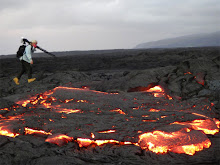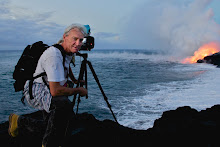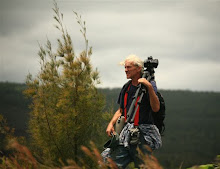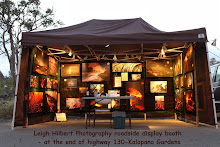
Kilauea Volcanoes summit, Pu`u O`o crater and the adjacent rifts have been registering some very notable changes. Those of you who have also been following the US Geological Survey (USGS) -- Hawaiian Volcano Observatory (HVO)
daily website updates, and their associated informative links, will already be alerted to some significant new developments.
I do not intend to mirror what the USGS/HVO is doing; in fact I am suggesting we all keep reading their updates.
The main notable volcano changes have been:
-- More frequent and higher ‘stands’ of molten lava rising inside the Halema’uma’u craters pit-vent – along with longer lasting high levels. In the past 24 hours one stand reached to within 235-ft (72-m) of the main crater floor - much higher than any previous levels. At one time the base level was closer to 660 feet down. A more recent base, or resting level, has been closer to 435 ft, but the ‘base’ seems to be continually rising as the months go by. The pit vent is about 460 ft (140 m) in diameter at the top (growing wider each month), and around 150 ft (65 m) at the bottom. Background tremor has been notably higher between stands they report.
-- An escalation of
earthquakes in the Kilauea region is being recorded by the vast array of seismographs; 40 quakes in 24-hours two days ago; with one as strong as 3.8 in magnitude, and 24 temblors in the past day. Seismologists become very alert to such changes because a rise in quake action can, and has in the past, indicated significant eruptive events.
-- Pu`u O`o crater, 12-miles (25 km) to the east-southeast of the summit, has also been experiencing a heightened eruptive cycle: Molten lava rivers and lakes and building spatter cones within the crater, along with increased temblors. These events have been somewhat intermittent but are significant crater building characteristics.
-- Increased Thanksgiving Eve Breakout (TEB) eruptive site activity:
This site and the rootless shield area makai (toward the sea) from it have been very active with surface flows of lava. A week ago some of these breakouts interrupted the newly established lava tube system feeding the coastal flats and ocean entries. There has also been an increase in recorded earthquakes in that higher elevaton area as well.
The finer nuances of these changes to the volcano action can be better understood by reading the
USGS reports and related links.

Shown above; during high-lava-stands the degassing fumes diminish greatly, as do the levels of glow at night. But in between these stands glow has been extra bright lately. Check out all the USGS web cams day and night
here
Meanwhile, down along the coastal flats lava continues to slowly advance through two forest patch remnants (kipuka) at about the 130 to 200-ft elevation. Surface flows also move further down and along side of the most recent flow that we had there a few months back; in November and December. Some of the lava branches have stalled.

This molten lava advance is still approximately 4,800 ft from any homes and is not moving directly toward them, but has been angling that way as it goes. There has been no reports of lava flowing into the sea since it ceased at two locations a week ago.
See my video footage of this weeks lava flow in
my lava field report for Big Island Video News. My report comes in the 2nd-half; after their take on the recent Kilauea changes. Click the highlighted text to open the reports.
~~~ I will add updates as activity warrants. ~~~

Just cooling - roping and banding pahoehoe. Photo taken February 10, 2011 at the new advancing lava flow near Kalapana Gardens. ((By the way, all images posted on this website are copyright of Leigh Hilbert Photography unless otherwise labeled. I reserve all rights to them. Permissions or license to use my images in any form must be from me in writing.))
 Above - Pulama Pali breakouts at the about the 700-foot elevation at daybreak this morning.
Above - Pulama Pali breakouts at the about the 700-foot elevation at daybreak this morning. Pre-dawn light.
Pre-dawn light.
 Below: Four hundred foot elevation with Kalapana Gardens homes in in the distance. Lava flowing down this eastern edge is overtopping the previous flow of November-January. It is also crossing over the 1986 and 1990 flows that lay just west of that large kipuka we see in the background of both these images.
Below: Four hundred foot elevation with Kalapana Gardens homes in in the distance. Lava flowing down this eastern edge is overtopping the previous flow of November-January. It is also crossing over the 1986 and 1990 flows that lay just west of that large kipuka we see in the background of both these images. There continues to be surface lava breakouts further down slope quite a ways from here. Those lower flows are generally in the same area they have been active for a couple of weeks. That area also is not advancing much, but is still quite active and accessible to the many new guided tour outfits. (Scroll below to my last few posts to see those surface flows)
There continues to be surface lava breakouts further down slope quite a ways from here. Those lower flows are generally in the same area they have been active for a couple of weeks. That area also is not advancing much, but is still quite active and accessible to the many new guided tour outfits. (Scroll below to my last few posts to see those surface flows)
 Molten mounds all over at the 800 to 900-foot elevation.
Molten mounds all over at the 800 to 900-foot elevation.

















































